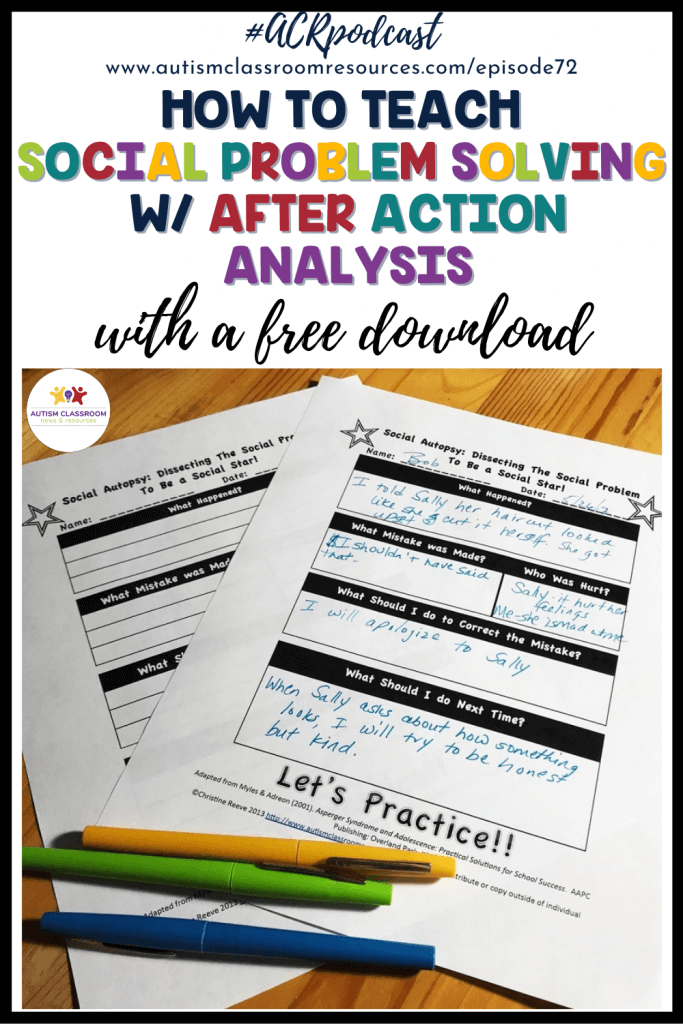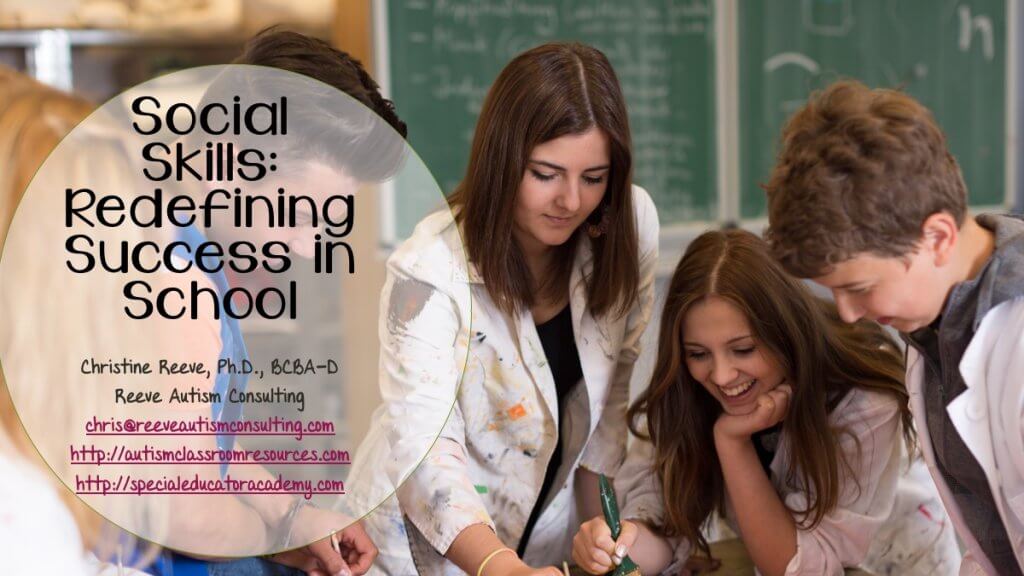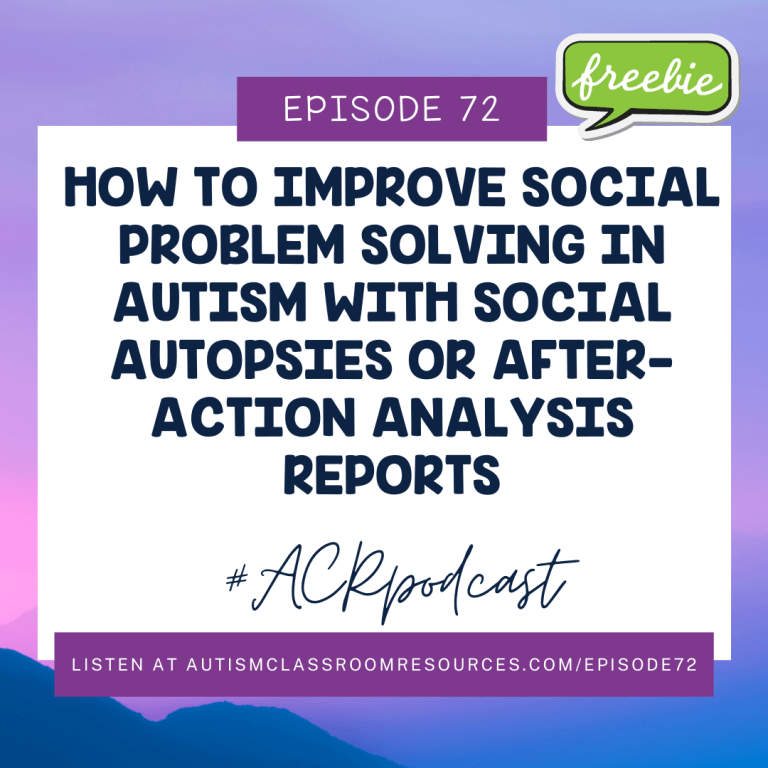As I talked about in Episode 69, students with high functioning autism struggle with social problem solving. Many of their behavioral challenges stem from difficulties with problem solving the many social situations they navigate each day in school and in their communities. In addition, social challenges are often the reasons that these highly qualified individuals lose out on competitive employment when they graduate.
The Impact of Problem Solving Problems
Over the years I’ve heard from so many employers about individuals with autism. Unequivocally their message is, “They can do the work. But they couldn’t get alone with their coworkers.” Or sometimes it’s that the worker was doing great until they encountered a situation where they had to problem solve with another person. Maybe they had to negotiate a situation with a coworker and couldn’t compromise well. Other times, it’s that they had difficulty seeing the perspective of how their behavior was impacting other people in the workplace. I’ve heard similar things from college professors over the years.
The common theme to all of these conversations, as well as the many k-12 teachers who say similar things, is that the students are smart. That the work was never the issue. The difficulty always comes from having to navigate and problem solve a social situation. As Dr. Kabot said in episodes 70 and 71, smart is not enough.
After-Action Analysis Reports for Problem Solving
In today’s episode I want to share a strategy that has become a huge tool for students to learn how to problem solve social situations. I’ve talked about it in the past and describe it in more detail in this post. Traditionally, the little literature we have about it, it’s called a social autopsy. However, I have found that many students (and sometimes teachers) hate this name. Because those students are really perceptive. Who wants to have their behavior autopsied after all!
So one of them suggested the name After-Action Reports. So I’m going to start referring to them as After-Action Analysis Reports. And it’s the analysis that is really key to helping students learn to problem solve.
Highlights of Episode 72
- Find out what a social autopsy is and how it can be used in a social skills program
- Learn how social autopsies, or after-action analysis (AAA) reports, can help your students problem solve social situations
- Discover 3 key elements of AAA reports that you must have to help them be effective for problem solving
- Learn how AAA reports can also save you, as an educator, time by serving as a data source for behavior
- And grab a free set of of social autopsies or after-action reports from the free resource library in the blog post at autismclassroomresources.com/episode72
Just a quick couple of housekeeping notes. You can find a free download in the blog post for this episode at autismclassroomresources.com/episode72. And if you are looking for a deeper dive into teaching social skills, we have a whole course on it in the Special Educator Academy. So come check it out with a free trial at specialeducatoracademy.com. I will be taking a week off next week and will probably have a new blog post up. But I’ll be back the next week as we gear up for Autism month, so I hope you’ll join me then.
Now, Let’s Get Started.
What Are Social Autopsies (Or AAA Reports)?
After-Action Analysis Reports are exactly what they sound like. They are a way for a student to review a social problem after it occurred. Typically these situations are ones that resulted in a behavior problem. But they could be any type of social situation that caused a problem of any kind. The process that it takes is the problem solving process. So define the problem, analyze it, draw conclusions and plan your action.
Define the Problem
Typically, after the situation, the student will work with an adult to tease apart how the situation occurred. They will work through what happened, to make sure that the facts are straight. And it’s always interesting to hear the situation from the student’s perspective. Because remember that students with autism often have difficulty understanding others’ perspectives. So, often when they describe a situation, it doesn’t look like what other people observed. This is useful information to us because it shows where they were coming from.
So let’s take a really minor example to demonstrate. Bob told Sally that her haircut looked like she cut it herself. Sally of course was mortified. Bob was mystified because he didn’t realize that this might not be perceived as a compliment. This particular issue is a pretty common hidden curriculum item, that we talked about in Episode 68.
What Mistake Was Made?
The next step is to talk about where the problem came in. What was the social error that occurred? How did it happen? Who did it affect?
In this case, Bob realizes that he shouldn’t have said that to Sally, based on her reaction. He noted that Sally was upset because he hurt her feelings. And he’s upset because Sally is mad at him.
What Should The Student Do To Correct The Mistake?
Once the student identifies the mistake, the next step is to determine what they need to do to correct the mistake. How should they make amends? Is there a way they can make up for what they did wrong to ease the hurt?
In our example, apologizing to Sally is the solution that Bob comes up with to correct the mistake. And in this minor example that’s probably sufficient. But if the situation ended in up with another student being hurt by aggression or property damage, then the problem solving process is going to be more intricate. The adult is going to have to help the student go beyond a simple apology. The student is probably going to have to do something to restore the situation in some way. And this is important because students shouldn’t just learn that apologies are all that are needed.
What Should the Student Do Next Time?
Once the student knows how to correct this particular situation, the analysis moves to how to prevent future problems around the same type of situation. In other words, this is where the problem solving helps them to learn to prevent future situations.
So, in Bob and Sally’s situation, Bob may note (as men would often say they have learned the hard way) that when Sally asks about how something looks, he will try to be honest but kind. So he has a strategy for how he is going to respond to this type of situation in the future.
Again, if it was a more serious situation, it would require more problem solving and more discussion to develop strategies. If the student became aggression, it would be a good time to talk about coping strategies to help them remain calm in the situation.
Role Playing: A Key Part of Problem Solving
Finally, a key part of the process has to be role playing the solutions. Learned behaviors don’t change just because we think they are a good idea. If they did, I would always eat healthy food and get enough sleep. And yet, I don’t. Changing behavior takes practice. Especially because challenging behavior, in particular, is often learned behavior that has been practiced. And often it’s been reinforced. So they have to practice repeatedly and be reinforced in order for the behavior to change.
Key Elements to Make After Action Reports Work
There are a few key elements you have to make sure you focus on to make this problem solving process effective for your students. First, make sure that you are completing the analysis process when the student is calm. This isn’t a strategy that you use when the student is in the middle of the behavioral issue. It’s called an AFTER action report for a reason. This is a debriefing process to analyze in retrospect. Because let’s face it, no one thinks clearly when upset.
Second, writing it down is really key because students see it more clearly. But they can also go back and review them periodically. I had a student who used to keep a notebook of his after action reports and go back over them when he wasn’t sure of something. He would find parallels in them to apply to situations he was trying to figure out. He used them as a resource.
Third, role playing, as I noted before is essential. Without role playing, this is just a lovely conversation. Without the practice and reinforcement (and feedback), it’s unlikely to change behavior.
Benefits of AAA For Problem Solving
The whole purpose of the social autopsy or after-action analysis process is designed to take the student through the problem solving process. The steps you are working through with the student are those we all use to figure out how to handle a situation when we aren’t sure of a situation.
Benefits to the Current Situation
So, first the student benefits because they learn a solution to the current situation. And they should come away with a solution that might translate to solving that particular type of situation in the future. So Bob knows now how to handle situations when a friend asks “How do you like my new haircut?” And maybe he generalizes that knowledge when a friend asks “Do you like this dress?” or other similar questions.
Benefits to Future Situations
But the bigger benefit of the after-action analysis process is to help the student to learn how to problem solve new situations. At first, they may learn how to problem solve after the fact, as we do with the AAA reports. But, over time, if they become more adept at it, they may learn to problem solve more quickly in the moment. And that may help them to avoid the problem situation in the first place.
Benefits to the Teacher
Finally, there are also benefits of the After Action Reports for the educators. First, the report process, while completed by the student and the adult together, serve as behavioral documentation. As such, since it outlines what happened during a behavioral incident, it can serve as your data. I’ve used these reports as a way to measure IEP goals for behavior or monitor behavior programs. We actually use the number of instances requiring a social autopsy / AAA report as an indicator of progress. And finally, the report also serves as documentation of implementing procedures that are (or should be) written into the behavior support plan. Maintaining a record of the reports provides you with evidence of implementation.
Summary of Resources for Problem Solving
I’m excited to say that you can download a free set of Social Autopsies and After Action Analysis Reports from the Free Resource Library. If you have the earlier set that has been in the library for a bit, it’s worth downloading them again as I’ve updated them to add a new set with the new name (the older ones are still there for consistency). I have a hard time letting go of the social autopsy name because we do have literature out there calling it that. But I also know our students don’t really care about that! So, hop over to the blog post at autismclassroomresources.com/episode72 and you can sign up or sign in and grab your free download as well as a transcript. And I’d love to know if you have used this type of process with your students, so if you are an educator, hop over to our free facebook group at specialeducatorsconnection.com and answer the questions and share.
I’ll be back in two weeks, as we gear up for Autism month, so I hope you’ll join me then. Until then, thank so much for tuning in and sharing your time with me. I know how precious it is. And as always, thanks so much for everything you do for your students.








